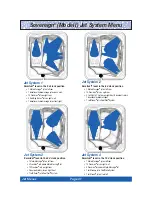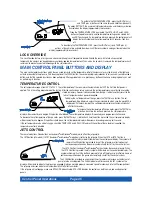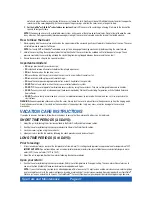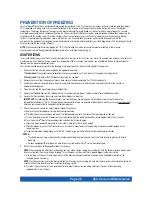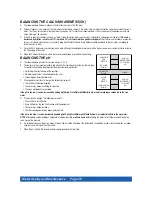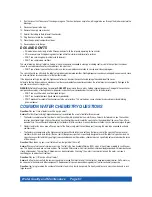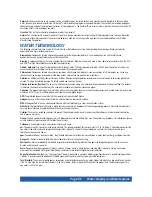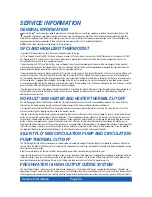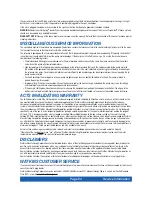
Page 44
• Accurately measure the exact quantities specified, never more. Do not overdose your spa.
• Handle all containers with care. Store in a cool, dry, well ventilated place.
• Always keep chemical containers closed when not in use. Replace caps on their proper containers.
• Don’t inhale fumes, or allow chemicals to come in contact with your eyes, nose, or mouth. Wash your hands immediately after use.
• Follow the emergency advice on the product label in case of accidental contact, or if the chemical is swallowed. Call a doctor or the local
Poison Control Center. If a doctor is needed, take the product container along with you so that the substance can be identified.
• Don’t let chemicals get on surrounding surfaces or landscaping. Don’t use a vacuum cleaner to clean up chemical spills.
• Never smoke around chemicals. Some fumes can be highly flammable.
• Don’t store any chemicals in the spa equipment compartment.
HOW TO ADD CHEMICALS TO THE WATER
IMPORTANT:
All spa water chemicals, including granulated dichlor, MPS, granulated pH increaser or decreaser, granulated total alkalinity
increaser, liquid stain and scale inhibitor, and liquid defoamer must always be added directly into the filter compartment while the jet pump is
running in its high speed mode, and it must run for a minimum of ten minutes.
To Administer Spa Water Chemicals:
1. Fold back the cover. Carefully remove and set aside the filter compartment cover.
2. Push the CLEAN button to turn on the jet pump.
3. Carefully measure the recommended amount of chemical and slowly pour it into the filter compartment. Use care not to splash chemicals on
your hands, in your eyes, on the spa shell surface, or on the spa cabinet.
4. Replace the filter compartment cover. After ten minutes, the jet pump will automatically shut off to complete the procedure. Close and secure
the cover.
Risk of Drowning:
Never leave an open spa unattended!
IMPORTANT “SUPER CHLORINATION/NON-CHLORINE SHOCK TREATMENT” NOTE:
After administering a super chlorination treatment or
non-chlorine shock to your spa, leave the cover open for a minimum of 20 minutes to allow the oxidizer gas to vent. A high concentration of
trapped oxidizer gas which may exist as a result of the shock treatment (not daily sanitation) may eventually cause discoloration or vinyl
degradation to the bottom of the cover. This type of damage is considered chemical abuse and is not covered under the terms of the limited
warranty.
THE HOT SPRING
®
SPA WATER MAINTENANCE
PROGRAM
Each step in your water maintenance program is dependent on the completion of the previous steps. Omitting a step, or failing to reach the
recommended range may cause an imbalance in your water chemistry. Unbalanced water chemistry can damage the spa, and its components, as
well as cause discomfort for the user.
FILLING THE SPA WITH WATER
A. To prevent contaminants from entering the spa, Watkins recommends using the FreshStart
®
10,000
pre-filter when filling the spa with water.
Always fill the spa through the filter compartment.
B. The FreshStart
10,000
pre-filter is designed to remove unwanted contaminants such as rust, dirt, detergents, and algae from the fill water.
Dissolved minerals and metals such as lead, calcium, copper, and iron are not removed.
C. Instructions are included with the FreshStart
®
10,000
pre-filter. When the spa is filled, proceed to the Start-Up and Refill Procedures section.
BALANCING THE TOTAL ALKALINITY (TA)
A. The recommended Total Alkalinity (TA) for your spa water is 125-150 ppm.
B. Total Alkalinity is a measure of the total levels of carbonates, bicarbonates, hydroxides, and other alkaline substances in the water. TA is
referred to as the water’s “pH buffer”. In other words, it’s a measure of the ability of the water to resist changes in pH level.
C. If the TA is too low, the pH level will fluctuate widely from high to low. Fluctuations in pH can cause corrosion or scaling of the spa
components.
Low TA can be corrected by adding Hot Spring FreshWater
®
pH/Alkalinity Up, or sodium hydrogen carbonate.
D. If the Total Alkalinity is too high, the pH level will tend to be high and may be difficult to bring down.
It can be lowered by adding Hot Spring
FreshWater pH/Alkalinity Down, or sodium bisulfate.
E. Once the TA is balanced, it normally remains stable, although the addition of more water with a high or low alkalinity will raise or lower the TA
reading of the water.
F. When the Total Alkalinity is within the recommended range, proceed to the next step.
Water Quality and Maintenance


